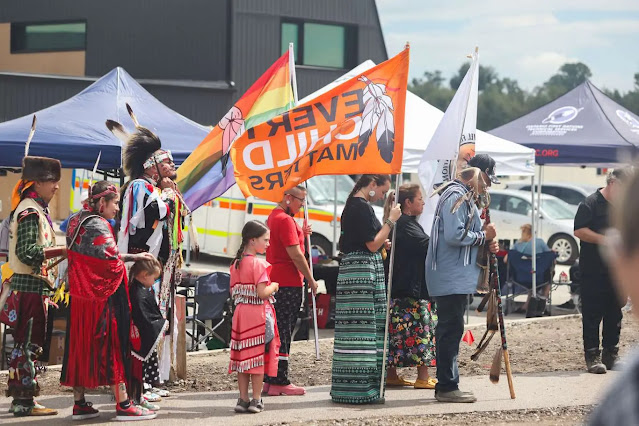The Land Back movement reflects the global efforts of Indigenous people
to reclaim ancestral territories and sovereignty over public lands.
Through a combination of military force, broken treaties, and
discriminatory policies, Native communities have been stripped of 99% of
their historical land base in the U.S., reduced from nearly 2.3 billion
acres to just 56 million acres today. Here are some ways this has been
codified in state and federal policy: |
The Indian Removal Act of 1830
led to the forced relocation of southeastern tribes like the Cherokee,
Muscogee (Creek), Seminole, Chickasaw, and Choctaw Nations along the
brutal Trail of Tears, where thousands died during the journey westward.
In the Great Plains, the U.S. government repeatedly violated treaties like the Fort Laramie Treaty of 1868, seizing the Black Hills from the Great Sioux Nation after gold was discovered. The Dawes Act of 1887
dispossessed tribes by breaking up communally held reservation lands
into individual allotments, many of which were then sold to non-Native
settlers. Military campaigns and massacres, like the Sand Creek Massacre of 1864
where U.S. troops killed hundreds of peaceful Cheyenne and Arapaho
people, were used to terrorize Indigenous communities and drive them
onto increasingly smaller reservations. The California Gold Rush led to state-sponsored genocide
of Native peoples, with the state paying bounties for Indian scalps and
heads in the 1850s and forcing survivors onto small rancherias.
|
Unlike what some might assume, the movement doesn't seek to displace
current residents from their homes. Instead, it focuses on returning
decision-making power to Indigenous communities and addressing the
historical injustices of colonization that led to their dispossession.
Here are four examples of what land back work looks like in action: |
In 2020, the Esselen Tribe regained 1,200 acres
of their ancestral homeland in Big Sur, California, after 250 years of
displacement. Through a $4.5 million grant and partnership with Western
Rivers Conservancy, the land, which includes sacred sites and endangered
species, is now being used for traditional ceremonies and ecological
conservation.
The Bois Forte Band of the Minnesota Chippewa Tribe, in partnership
with The Conservation Fund, the Indian Land Tenure Foundation and the
Indian Land Capital Company, purchased 28,089 acres of ancestral land
within the Nett Lake and Deer Creek sections of the Bois Forte
Reservation. The Confederated Salish and Kootenai Tribes (CSKT) regained control
of the National Bison Range in Montana in 2020. This 18,800-acre
wildlife refuge, which was taken from them in 1908, is being used for
bison conservation efforts while expanding public education about their
cultural connections to the land. In Maine, the Penobscot Nation has worked with conservation groups to reclaim over 100,000 acres
of their ancestral territory along the Penobscot River since 2000,
helping restore both tribal sovereignty and the river's ecological
health, including critical salmon habitats. In South Dakota, the Rosebud Sioux Tribe reacquired 28,000 acres of land
in 2020. This prairie land is now being used for buffalo conservation,
food sovereignty initiatives, and teaching traditional land management
practices to tribal youth.
|
Indigenous communities’ approach to land stewardship goes beyond simple
ownership, emphasizing a deep, complex relationship with the
environment. As tribes reclaim more of their ancestral lands, they're
leading innovative climate adaptation efforts and restoration projects,
demonstrating how traditional Indigenous knowledge can help create a
more sustainable future. |
|
Support the work of NDN Collective,
an Indigenous-led organization dedicated to building Indigenous power
through organizing, activism, philanthropy, grantmaking,
capacity-building and narrative change. You can make a donation or follow the action items for their specific initiatives. Learn whose ancestral land you live on and
pay real estate taxes to those Indigenous nations. Many tribes and
Indigenous organizations have established voluntary land tax programs
where residents can contribute a portion of their income or property
value to support Indigenous land reclamation efforts, like the Shuumi Land Trust in the East Bay of Northern California. Support Indigenous-led land conservation efforts
and organizations working to protect sacred sites and expand tribal
land holdings. This could mean donating to Indigenous land trusts,
advocating for the return of public lands to tribal management, or
backing specific land return campaigns. Call on your local, state and federal representatives to honor treaties, expand tribal sovereignty, and return public lands to tribal nations.
|
|
The latest on the Land Back movement, in which Native American tribes reclaim land. Two reporters take a look at where it’s worked and where it hasn’t at reservations in Minnesota. NPR > |
The Land Back movement is also about foodways.
When Native peoples' land was stolen, they lost important hunting and
fishing grounds and myriad places to gather and prepare food. Civil Eats > |
Tribal lands were stolen. What happens when those ancestral territories are returned? The Land Back movement is long-overdue justice. It’s also a climate solution. Vox > |
The Land Back Movement Unravels Manifest Destiny. Across Indian Country, tribal nations are buying back their land one parcel at a time. Sierra Club > |
On Vancouver Island, Land Back Looks Like Going Home.
Indigenous-led land back efforts are underway on Canada’s Vancouver
Island while the land’s original stewards protect forests from logging. Atmos > |
Land
Rematriation: A Conversation with Cyndi Suarez, Donald Soctomah, Darren
Ranco, Mali Obomsawin, Gabriela Alcalde, and Kate Dempsey. Kate
Dempsey, state director of The Nature Conservancy in Maine, discuss the
future of Tribal sovereignty, Land Back, and rematriation of the planet.
NPQ > |
|



























No comments:
Post a Comment
Please: Share your reaction, your thoughts, and your opinions. Be passionate, be unapologetic. Offensive remarks will not be published. We are getting more and more spam. Comments will be monitored.
Use the comment form at the bottom of this website which is private and sent direct to Trace.